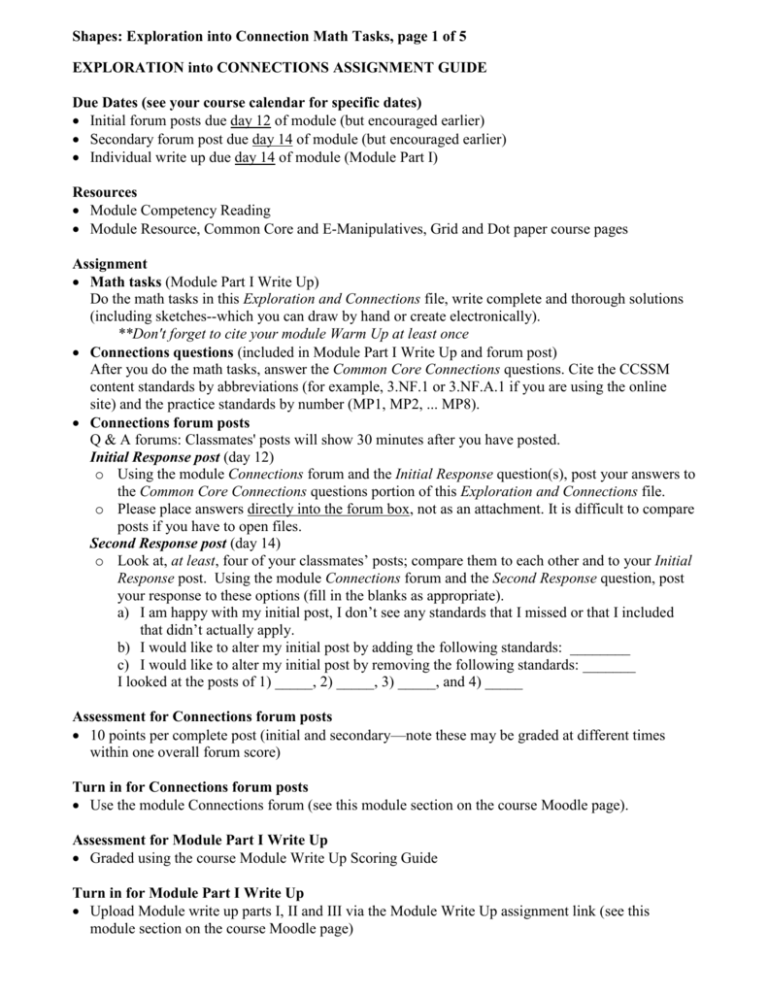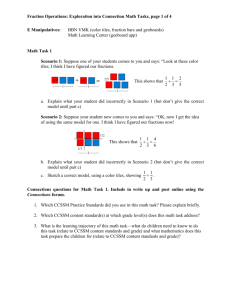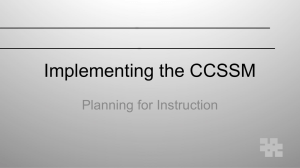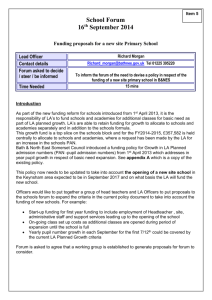3. Exploration into Connection Math Tasks
advertisement

Shapes: Exploration into Connection Math Tasks, page 1 of 5 EXPLORATION into CONNECTIONS ASSIGNMENT GUIDE Due Dates (see your course calendar for specific dates) Initial forum posts due day 12 of module (but encouraged earlier) Secondary forum post due day 14 of module (but encouraged earlier) Individual write up due day 14 of module (Module Part I) Resources Module Competency Reading Module Resource, Common Core and E-Manipulatives, Grid and Dot paper course pages Assignment Math tasks (Module Part I Write Up) Do the math tasks in this Exploration and Connections file, write complete and thorough solutions (including sketches--which you can draw by hand or create electronically). **Don't forget to cite your module Warm Up at least once Connections questions (included in Module Part I Write Up and forum post) After you do the math tasks, answer the Common Core Connections questions. Cite the CCSSM content standards by abbreviations (for example, 3.NF.1 or 3.NF.A.1 if you are using the online site) and the practice standards by number (MP1, MP2, ... MP8). Connections forum posts Q & A forums: Classmates' posts will show 30 minutes after you have posted. Initial Response post (day 12) o Using the module Connections forum and the Initial Response question(s), post your answers to the Common Core Connections questions portion of this Exploration and Connections file. o Please place answers directly into the forum box, not as an attachment. It is difficult to compare posts if you have to open files. Second Response post (day 14) o Look at, at least, four of your classmates’ posts; compare them to each other and to your Initial Response post. Using the module Connections forum and the Second Response question, post your response to these options (fill in the blanks as appropriate). a) I am happy with my initial post, I don’t see any standards that I missed or that I included that didn’t actually apply. b) I would like to alter my initial post by adding the following standards: ________ c) I would like to alter my initial post by removing the following standards: _______ I looked at the posts of 1) _____, 2) _____, 3) _____, and 4) _____ Assessment for Connections forum posts 10 points per complete post (initial and secondary—note these may be graded at different times within one overall forum score) Turn in for Connections forum posts Use the module Connections forum (see this module section on the course Moodle page). Assessment for Module Part I Write Up Graded using the course Module Write Up Scoring Guide Turn in for Module Part I Write Up Upload Module write up parts I, II and III via the Module Write Up assignment link (see this module section on the course Moodle page) Shapes: Exploration into Connection Math Tasks, page 2 of 5 Math Task 1: Quilt Patch Designs For this activity, you will need another person. Ideally this should be a child (elementary school student or your child), but another adult is acceptable if no children are available for you to work with. Write Up Directions 1. After finding a partner, play at least one round (both partners make a secret quilt) of the Quilt Design game described below. 2. If you can, record the quilt images (sketch or photo) to include with your write up. 3. With your partner, answer questions 4a-e and include the answers in your write up. 4. Answer the follow up questions 6a-e. Ideally you can also explore these questions with your partner, but this is optional. Indicate whether your answers are individual or partner work in your write up. It will be more interesting to think about what a kid will say about these questions than it will be to answer these questions on your own. (Secret) QUILT DESIGN GAME Adapted from ideas in NCTM’s “Navigating Through Geometry in Grade 3 – 5” Materials: Pattern Blocks Directions 1. Using 10 – 20 pattern blocks in a contiguous arrangement, one person designs a "secret quilt patch" (for example, see the diagram below) from pattern blocks without their partner seeing it. 2. The creator of the secrete design gives directions out loud to their partner so the partner can recreate the design without looking at it. There are no restrictions on these verbal directions. 3. The re-creator now describes to the designer what the quilt patch looks like. 4. The partners compare the designs visually and answer questions a-e. a. What words or phrases helped you recreate the design? b. What words or phrases confused you? Why? c. Can you think of better ways to explain the directions for making the design? d. What are the names of the pattern block pieces? e. How many sides does your quilt block have? 5. Repeat 1 – 4 with partners switching roles. 6. Follow up questions a. How many ways can you make a quadrilateral by putting different pattern block pieces together? Show at least four examples. b. What are the names for the quadrilaterals you made? c. Which quadrilaterals are the same size and shape (congruent)? How can you tell? d. Can you make a five-sided shape with pattern blocks? A six–sided shape? A sevensided shape? e. What patterns do you notice? Shapes: Exploration into Connection Math Tasks, page 3 of 5 Connections questions for Math Task 1 Post online using the Connections forum Initial Response question for Math Task 1. 1. (Standards) The CCSSM Practice standard(s) Math Task 1 addresses are: ___ 2. (Standards) The CCSSM Content standard(s) Math Task 1 addresses are: ___ 3. (Learning trajectories) What do children need to know to do Math Task 1? (Relate to CCSSM content standards) 4. (Learning trajectories) What mathematics does Math Task 1 prepare children for? (Relate to CCSSM content standards) Shapes: Exploration into Connection Math Tasks, page 4 of 5 Math Task 2: Decomposing and Composing Shapes with Geoboards 1. Divide this shape into three triangles that are all the same. Explain how you know they are the same triangle. Can you do this in more than one way? 2. Divide this shape into four triangles that are all the same. Explain how you know they are the same triangle. Can you do this in more than one way? 3. What is the fewest number of triangles that will fill this shape? Explain how you know. Can you do this in more than one way? 4. Divide this shape into three rectangles that are all the same. Explain how you know they are the same rectangle. Can you do this in more than one way? 5. Make a shape on your geoboard using six triangles that are all the same and then re-divide your shape in a different way using six triangles that are all the same. Use a shape that can be composed of six triangles in at least two ways. 6. Make a shape that is not a rectangle on your geoboard using four non-square rectangles that are all the same and then re-divide your shape in a different way using four rectangles that are all the same. Use a shape that can be composed of four rectangles in at least two ways. Connections questions for Math Task 2 Post online using the Connections forum Initial Response questions for Math Task 2 1. (Standards) The CCSSM Practice standard(s) Math Task 2 addresses are: ___ 2. (Standards) The CCSSM Content standard(s) Math Task 2 addresses are: ___ 3. (Learning trajectories) What do children need to know to do Math Task 2? (Relate to CCSSM content standards) 4. (Learning trajectories) What mathematics does Math Task 2 prepare children for? (Relate to CCSSM content standards) Shapes: Exploration into Connection Math Tasks, page 5 of 5 Math Task 3: Solids and Nets Base I. II. Cirlce Square III. Cirlce IV. Rectangle V. Equilateral triangle VI. Square VII. VIII. Right scalene triangle Regular hexagon IX. Equilateral triangle For each shape: 1. Precisely name the three-dimensional shape. 2. Sketch and clearly label a net of the shape. Try really hard to do it without looking it up or asking someone else. If you look it up, please mention this in your write up. You aren’t given measurements, but sketch congruent faces so they look congruent and include angle and congruence marks so a reader can tell which sides you mean to be congruent, and which angles you mean to be right, etc. 3. Precisely name the two-dimensional shapes that make up the net for the three-dimensional shape. 4. Answer this question: For three-dimensional shapes in this category (example, prism), are the twodimensional shapes that make up the net always the same or are there different options? Explain. Connections questions for Math Task 3 Post online using the Connections forum Initial Response questions for Math Task 3 1. (Standards) The CCSSM Practice standard(s) Math Task 3 addresses are: ___ 2. (Standards) The CCSSM Content standard(s) Math Task 3 addresses are: ___ 3. (Learning trajectories) What do children need to know to do Math Task 3? (Relate to CCSSM content standards) 4. (Learning trajectories) What mathematics does Math Task 3 prepare children for? (Relate to CCSSM content standards)






